By Mike Foley
Engineer John Bradfield’s grand plan to irrigate the dry, dusty interior of the continent has captured the national imagination and spawned countless campaigns to fund it. Now, 80 years after he proposed it, CSIRO has counted the project’s cost and even the most optimistic assumptions show taxpayers footing a $20 billion bill, or more.
The national science agency crunched the numbers on reversing the flow of North Queensland’s rivers and CSIRO’s report is grim reading for advocates of Bradfield’s vision. It looks like the nuclear energy of water policy – popular among some in the public but economically doomed due to its expense and environmental risks.
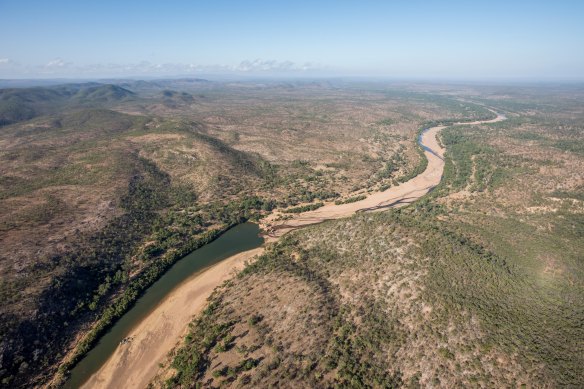
The Burdekin River in northern Queensland, which is the centrepiece of the Bradfield scheme.Credit: CSIRO
“We came to a conclusion that, as a grand scheme, it’s difficult, no matter what you do, to make it work. And we’ve tried to maximise its opportunity to work,” CSIRO deputy director land and water Chris Chilcott said.
Conceived by its namesake John Bradfield, the engineer who designed and built the Sydney Harbour Bridge, the scheme was designed in 1942 on a continental scale to divert the upper Tully and Herbert rivers into a new dam at a place called Hells Gate on the Burdekin River in far north Queensland.
Since then, not a year has gone by without a public campaign or push from a political party to build it.
The National Party is one of the most ardent proponents of the scheme. Former party leader and then infrastructure minister Michael McCormack made an assessment of the Bradfield scheme the first priority of the National Water Grid Authority he set up in 2019.
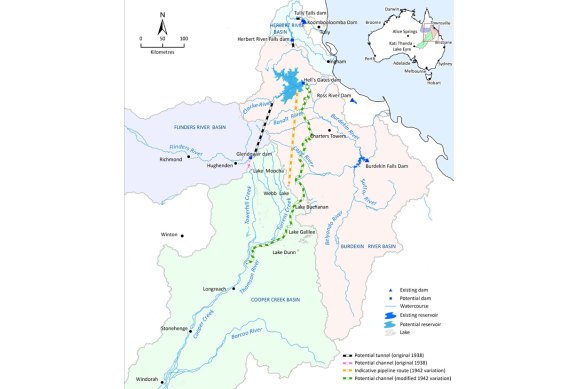
CSIRO Bradfield scheme assessment.Credit: CSIRO
The authority commissioned the national science agency to conduct a full assessment and now, after years of work, CSIRO has published the first comprehensive assessment of Bradfield’s vision.
Bradfield’s plan hinged on a 152-metre-high wall to create a Hells Gate dam with an immense capacity. He assumed his scheme would deliver 3800 gigalitres for irrigation in an average year – a whopping figure given the entire Murray-Darling Basin has allocated an average of about 5000 megalitres a year for irrigation since 2015.
But due to the relatively scant hydrological information available at the time, Bradfield made a crucial error and overestimated by double the volume of water that would flow into his dam.
CSIRO found the evaporation rate across the massive reservoir in the hot north Queensland climate would exceed the annual inflows.
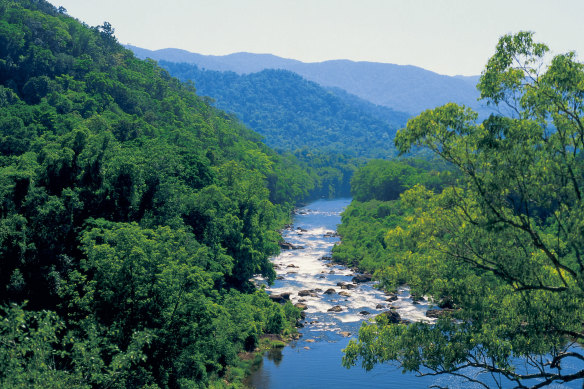
The Bradfield scheme would divert the upper Tully River.Credit: Tourism Queensland
Bradfield assumed that black soil plans along the Torrens Creek, a tributary of the Thompson River upstream of Longreach, would be used to grow irrigated crops with water from his dam. But CSIRO found the soil was too saline for agriculture.
These factors make Bradfield’s original scheme unworkable.
But CSIRO wanted to find out if it could make it work with modern technology and the team rejigged the plan to maximise its potential.
CSIRO settled on a 98-metre-high wall at Hells Gate that could create a dam capable of delivering, on average, 1880 gigalitres of irrigation water a year. The CSIRO plan would deliver the water into the Thompson River further downstream than Bradfield’s original design via a 680-kilometre open channel. It identified enough soil to support the most viable crops, which would be 30,000 of irrigated mandarins and 150,000 hectares for cotton.
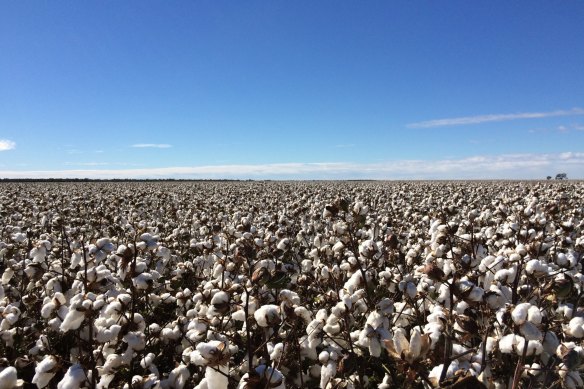
CSIRO factored in the planting of 150,000 hectares of cotton to maximise the potential of the scheme, but it still failed to justify its building costs.
CSIRO said its modern variation would cost at least $12 billion “under an optimistic set of assumptions” across a 100-year project lifespan and farmers would have to pay $970 a megalitre for their irrigation entitlements to cover the cost of supplying the water.
Last year irrigators in Victoria and NSW paid about $55 a megalitre on average, and $100 in South Australia.
CSIRO estimated that irrigators relying on the Bradfield scheme would be able to afford $80 a megalitre at most, which meant the “cashflow of the scheme remained almost entirely negative” in any scenario it modelled.
But CSIRO did not limit its assessment to the scope of Bradfield’s plan and identified an even grander scheme in an attempt to make Bradfield’s vision viable.
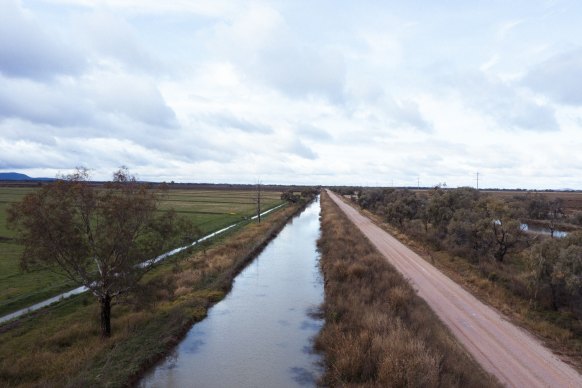
Last year, irrigators in NSW paid on average $55 a megalitre for water.Credit: Dominic Lorrimer
CSIRO’s optimised version would also use a 98-metre-high dam wall and run a huge 1600 kilometre open channel all the way south from the Burdekin River to the northern reaches of the Murray Darling Basin around St George in southern Queensland – largely because that’s where a new irrigation scheme could access enough good soil to use all the available water on crops.
But this version still wouldn’t be economically viable.
CSIRO found that even using “extremely optimistic assumptions” the bill for the project would be $21 billion, and the resulting irrigation scheme would only generate enough farm revenue to pay back 8 per cent of that bill.
Expanding irrigation around St George could create 11,000 jobs and boost the regional economy by $6 billion – with two big caveats.
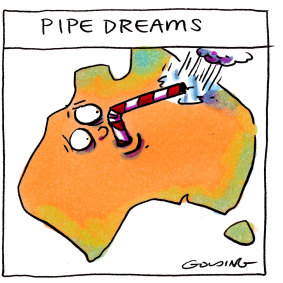
Illustration: Matt GoldingCredit:
The horticulture production in the region would have to expand to be equivalent to 30 per cent of
the gross value of all fruit, vegetable and nuts currently produced across Australia, which
CSIRO said would take more than 100 years to achieve, if it was even possible, and farmers would need to be gifted their water for free.
University of NSW professor Stuart Khan, who was appointed as an advisor to the National Water Grid before it was disbanded by Barnaby Joyce in March, said CSIRO had approached its assessment of the Bradfield scheme “very optimistically, very genuinely willing to spend millions of dollars on doing a proper appraisal”.
“But even looking at everything in the most optimistic terms they still weren’t able to demonstrate that the scheme would actually make more money than it would cost.
“All that agriculture product would be going to export and that means that Australian taxpayers would be subsidising the price of food in China, Japan, the USA – the various places that we send food to – we’d actually be paying for their lunch.”
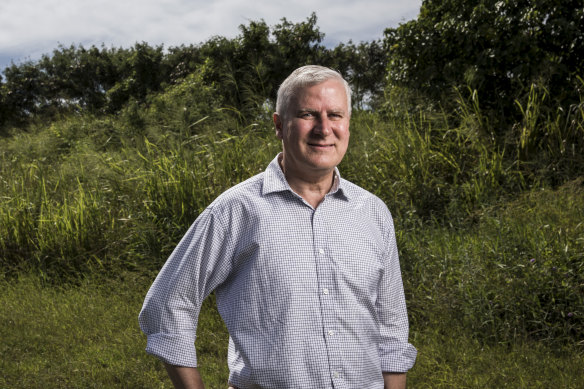
Michael McCormack regrets the focus on the bottom line applied to modern water projects.Credit: Dominic Lorrimer
The former Morrison government went to the 2022 federal election with a $5.4 billion promise to build a small version of Bradfield’s Hells Gate on the Burdekin River, but did not deliver a detailed project design or an assessment of its cost or viability.
Michael McCormack, who commissioned the CSIRO study, said it was regrettable that contemporary assessments of water storage projects were focused on “bottom line” assessments.
“If we had this sort of vision in the past we would never have built the Sydney Harbour Bridge, we would never have built the Snowy Hydro Scheme,” he said.
CSIRO recommended government investigate strategic, smaller water storage in north Queensland.
McCormack agreed with this approach, arguing the government should build the Hells Gate dam and focus on growing local irrigation districts.
“It’s not a full-blown Bradfield scheme, but we should build Hills Gate and make sure that we take advantage of it.”
Water Minister Tanya Plibersek, who is responsible for water infrastructure declined to comment on the future of the Hells Gate project. The Albanese government has not ruled out building it and is conducting a one-year review of the project.
Queensland’s opposition leader Deb Frecklington went to the 2020 state election pledging to defy “doubters and naysayers” and publicly fund the massive infrastructure works the Bradfield scheme needs, and a nervous Labor state government commissioned an independent report to investigate its viability.
Get to the heart of what’s happening with climate change and the environment. Our fortnightly Environment newsletter brings you the news, the issues and the solutions. Sign up here.